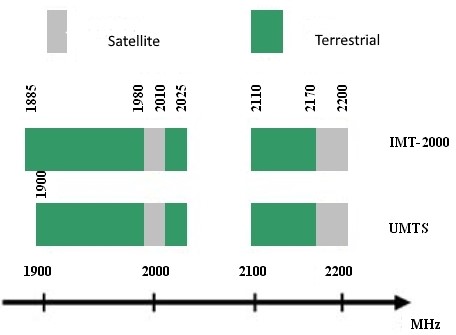3-4 G and 5 G antenna
Generational development of mobile systems
First generation mobile systems
First generation analogue cellular telephone systems started to spread in the early 80's, building independent systems. The number of users was low.
Second generation mobile systems
Mobile communications services of this generation are characterized by the combination of different digital technologies (GSM, IS-95, PDC). The development of the single pan-European digital cellular system started in 1982. Since 1992, GSM networks typically operated in the 900 and 1800 [MHz] frequency ranges (verbal communication, SMS, CSA).
With the further development of 2G systems, HSRSD (High Speed Circuit Switched Data) and GPRS (General Packet Radio Service) services are introduced
EDGE (Enhanced Data RAM for Global Evolution) technology is an advanced element of the evolution of the GSM system, which triples GPRS data rate by using a new radio modulation system. The introduction of EDGE started in 2002. It is also called 2,75G technology.

3G systems
UMTS (Universal Mobile Telecommunication System) system was developed in Europe in addition to the existing 2G system. It is characterised by hierarchical cell structure, high bandwidth and high data rate.
A new trend was emerging, the GMPCS (Global Mobile Personal Communications by Satellite): a global satellite-based mobile personal communication technology.

(Figure 3. 6.) Original UMTS/IMT-2000 frequency bandwidth of WRC-92
HSDPA (High-Speed Downlink Packet Access) technology opened way to the 4G technology.
4G systems
The appearance of new technologies. HSDPA+, WLAN, WIMAX, LTE
By WIMAX standard, the 4G system operates at 2 and 6 Mbps, while with LTE technology 4G operates between 5 and 10 Mbps. 4G mobile phones are served with a faster and more reliable broadband. Streamed videos can be played in HD quality, and high-definition video conferencing or network group working are also possible.
5G
The system is currently under development. Commercial introduction is planned for 2020.
Increasing data volumes and data rates, new directions of use require the further development of the existing systems. New frequency bands need to be released and utilised with the least energy-efficient high-speed technologies
According to the Next Generation Mobile Networks Alliance, the 5G standard must meet the following specifications:
For tens of thousands of users, data density must be 10 megabits per second.
Provide 100 megabits per second data rate in a metropolitan environment.
1 Gigabit data transmission should be available for employees working on the same office level.
Wireless sensor networks should have hundreds of thousands of members.
Increasing coverage
Significant efficiency increase
Considerably decreasing latency compared to LTE.
One of the most revolutionary novelties of the 5G is that each device has a certain bandwidth internet connection that is appropriate to the use of the device. 5G will be able to work on a wide spectrum of frequencies. The network must be able to serve 1 million devices with 100 Mbps average speed in a 1 square kilometre area. 5G is expected to become a global standard.
New utilisation methods will appear in the different areas of the economy. Connecting to the 5G networks, smart cars, smart homes and smart cities will develop.
Applied and expanding Technologies LTE, LTE-A, LTE-A Pro
IoT refers to the Internet of Things - intelligent sensors on machines and equipment, and even on individual animals on farms. IoA refers to the Internet of Animals.
Continuous communication between machine and machine (M2M). Machines, mobile devices, drones, satellites, databases that can be reached everywhere, well-organized, almost utopian networks of smart cities.
